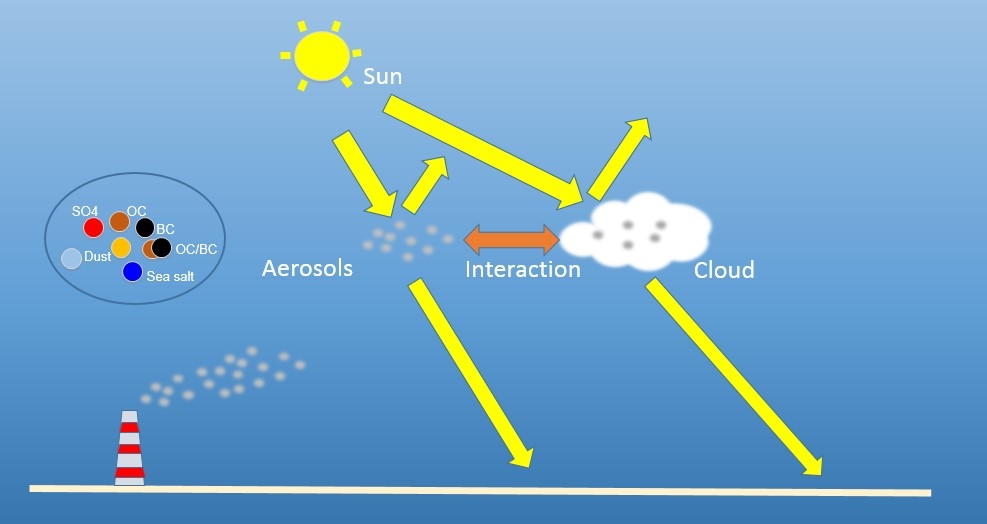中国科学院大气物理研究所大气科学和地球流体力学数值模拟国家重点实验室
State Key Laboratory of Numerical Modeling for Atmospheric Sciences and
Geophysical Fluid Dynamics (LASG)
Institute of Atmospheric Physics, Chinese Academy of Sciences
State Key Laboratory of Numerical Modeling for Atmospheric Sciences and
Geophysical Fluid Dynamics (LASG)
Institute of Atmospheric Physics, Chinese Academy of Sciences

Vol.15/No.15 April 2021
A New Online Coupled Aerosol Climate Model for Better Understanding of Aerosol's Climate Effect
The online coupled aerosol climate model is an important tool to reduce the uncertainty and help scientists understand how the aerosol impacts the climate and environment. Recently, the Institute of Atmospheric Physics at the Chinese Academy of Sciences, through long-term cooperation with the National Institute for Environmental Study of Japan, Kyushu University and the Japan Aerospace Exploration Agency, has successfully implemented an aerosol module named SPRINTARS into the global coupled climate model CAS FGOALS-f3.
"CAS FGOALS-f3 is independently developed by Chinese scientists. Its previous version uses the prescribed aerosols and can not depict the process of aerosol cycle and the cloud-precipitation-radiation-dynamic interactions. Our work makes up for these disadvantages.” Said Dr. DAI Tie, the corresponding author of the series of studies published in Journal of Geophysical Research: Atmospheres and Atmosphere. "The global fully aerosol coupled model CAS FGOALS-f3 can simulate the life cycles of the multiple aerosol components, including carbonacesous aerosols, dust, sulfate, and sea salt."
DAI and his PhD student WANG Hao compare the model simulated results with the ground and multi-source satellite observations and found that the new coupled model could reasonably reproduce the spatial distributions of the global aerosol surface mass concentrations and the associated optical properties.

Schematic diagram of the coupled framework of aerosol modules and climate models. (Image by WANG Hao)
"In addition, based on the protocol of current Coupled Model Intercomparison Project phase 6, we also found that the new coupled model can reasonably reproduce the global spatial distributions of the effective radiative forcing of aerosol-radiation interactions and aerosol-cloud interactions", said DAI. DAI and his team will use this coupled climate system model to study the impact of aerosol on climate and environment and contribute to realize China's carbon neutrality.
This work was financially supported by the National Natural Science Funds of China (41875133, 41590875, and 41605083), the Youth Innovation Promotion Association CAS (2020078), the Strategic Priority Research Program of the Chinese Academy of Sciences (XDA2006010302), and the National Key R&D Program of China (2017YFC0209803, 2016YFC0202001).
References:
Hao Wang, Tie Dai*, Daisuke Goto, Qing Bao, Bian He, Yimin Liu, Toshihiko Takemura, Teruyuki Nakajima, Guangyu Shi (2020). Simulating and Evaluating Global Aerosol Distributions With the Online Aerosol-Coupled CAS-FGOALS Model. Journal of Geophysical Research: Atmospheres, 125, e2019JD032097. https://doi.org/10.1029/2019JD032097
Link: https://agupubs.onlinelibrary.wiley.com/doi/10.1029/2019JD032097
Link:https://www.mdpi.com/2073-4433/11/10/1115
Add: No.40, Huayanli, Beichen West Road, Chaoyang District, Beijing P.O. Box 9804, 100029, China
E-mail: lasg_newsletter@lasg.iap.ac.cn
Editors: Chuanyi Wang (wangcy@lasg.iap.ac.cn), Kangjun Chen(ckj@lasg.iap.ac.cn)
E-mail: lasg_newsletter@lasg.iap.ac.cn
Editors: Chuanyi Wang (wangcy@lasg.iap.ac.cn), Kangjun Chen(ckj@lasg.iap.ac.cn)